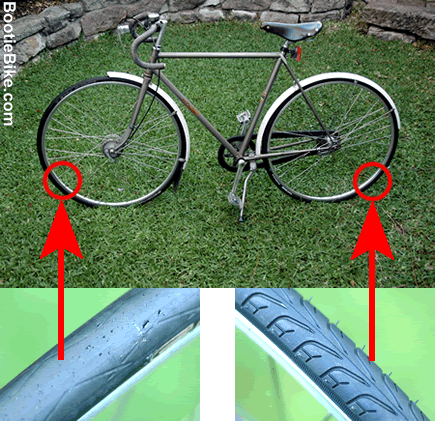This may be of interest if you're a transport cyclist who's looking for ways to minimise flats, maintenance and expense without sacrificing safety and riding fun. It's based on the premise that the front and rear tyres do different jobs, so the requirements of each are different. The message here is to choose the right tyre for the job, and in this regard a little thought and experiment can make a big difference.
Different jobs for front and rear wheels
The front wheel does the steering and most of the braking (the result of weight transfer). It makes sense then to get as much grip as you can get on the front tyre, as a loss of traction invariably means a fall. However, on the rear tyre, where a momentary loss of traction is not a problem, grip is less of a priority.
But getting a flat tyre is always a problem, and you'd be painfully aware that it's usually the rear tyre that's the culprit. This is because the rear wheel carries most of the weight and has to absorb more shock from hitting objects and pavement irregularities. This is why trad English bikes had more spokes on the rear than on the front (40/32).
The design of each tyre leans towards a particular type of use
Tyres are made to balance a range of characteristics, including grip, strength, puncture resistance, service life and cost. No tyre can have the best of everything, so each is designed to serve a particular market segment, whether that be offroaders, utility riders, road racers or whatever. Each design is a unique compromise that tilts the balance of characteristics in favour of the desired usage.
Some will prioritise grip, some toughness and durability and others different things again. Those designed for maximum grip will have soft rubber that wears relatively quickly and is vulnerable to damage. On the other hand, those that prioritise other characteristics may have less grip but more resistance to damage.
Considering the science that goes into making a tyre more suitable for this or that purpose, and the fact that the front and back wheels have such divergent functions, one has to wonder why most riders are content to have the same type of tyre on each end.
Tyres on the pictured bike
The bike pictured above may serve as an an example. It currently has a Schwalbe Durano Plus on the front and a Vittoria Randonneur on the rear.
The Durano Plus has very soft rubber and is very grippy. When used on the rear it was constantly getting flats. Small bits of glass and other sharp objects would embed themselves in the rubber and work their way through to the tube, despite the anti-puncture layer beneath the surface.  Cuts remained in the rubber where the sharp objects had been removed. On one occasion a cut spread open and rendered the tyre unsafe to use.
Cuts remained in the rubber where the sharp objects had been removed. On one occasion a cut spread open and rendered the tyre unsafe to use.
However, the same, ultra-grippy tyre has proved very suitable for the front, where grip matters most, and it soldiers on with only minor sharp-object damage – and no flats.
On the rear, where toughness and durability have more importance, the Randonneur has been giving great service. The harder rubber on this tyre does not collect sharp objects. It doesn't look or feel anywhere near as grippy as the Schwalbe, but after many many kilometres, in all weather, it has not given any cause for concern.
Postscript: The Vittoria Randonneur on the rear has long since worn out and been replaced by newer-design tyres; the battlescarred Durano Plus on the front lives on.


